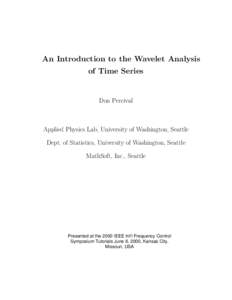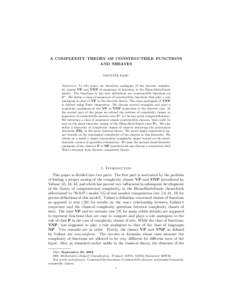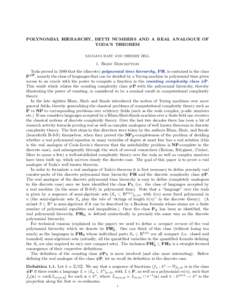291 | Add to Reading ListSource URL: www.ieee-uffc.orgLanguage: English - Date: 2013-06-18 15:29:54
|
|---|
292![POLYNOMIAL HIERARCHY, BETTI NUMBERS AND A REAL ANALOGUE OF TODA’S THEOREM SAUGATA BASU AND THIERRY ZELL Abstract. Toda [36] proved in 1989 that the (discrete) polynomial time hierarchy, PH, is contained in the class P# POLYNOMIAL HIERARCHY, BETTI NUMBERS AND A REAL ANALOGUE OF TODA’S THEOREM SAUGATA BASU AND THIERRY ZELL Abstract. Toda [36] proved in 1989 that the (discrete) polynomial time hierarchy, PH, is contained in the class P#](https://www.pdfsearch.io/img/a61205ad3f4d12997057467f01028bef.jpg) | Add to Reading ListSource URL: www.math.purdue.eduLanguage: English - Date: 2010-06-16 13:44:12
|
|---|
293 | Add to Reading ListSource URL: www.math.purdue.eduLanguage: English - Date: 2013-10-06 09:48:25
|
|---|
294 | Add to Reading ListSource URL: www.math.purdue.eduLanguage: English - Date: 2010-06-16 13:35:58
|
|---|
295![A COMPLEX ANALOGUE OF TODA’S THEOREM SAUGATA BASU Abstract. Toda [28] proved in 1989 that the (discrete) polynomial time hierarchy, PH, is contained in the class P#P , namely the class of languages that can be decided A COMPLEX ANALOGUE OF TODA’S THEOREM SAUGATA BASU Abstract. Toda [28] proved in 1989 that the (discrete) polynomial time hierarchy, PH, is contained in the class P#P , namely the class of languages that can be decided](https://www.pdfsearch.io/img/c7604a1f1bac70f2bd687c1be2b31274.jpg) | Add to Reading ListSource URL: www.math.purdue.eduLanguage: English - Date: 2011-09-22 08:25:51
|
|---|
296 | Add to Reading ListSource URL: www.ieee-uffc.orgLanguage: English - Date: 2013-06-18 15:23:17
|
|---|
297 | Add to Reading ListSource URL: www.medical-science.site88.netLanguage: English - Date: 2013-01-31 20:26:38
|
|---|
298 | Add to Reading ListSource URL: www.modern-medical-science.site88.netLanguage: English - Date: 2013-02-01 19:59:08
|
|---|
299 | Add to Reading ListSource URL: www.sbirc.ed.ac.ukLanguage: English - Date: 2012-02-08 11:14:46
|
|---|
300 | Add to Reading ListSource URL: doctord.dyndns.orgLanguage: English - Date: 2009-08-22 12:30:25
|
|---|